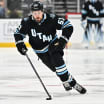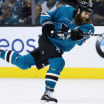The Coaches Room is a weekly column by one of four former NHL coaches and assistants who will turn their critical gaze to the game and explain it through the lens of a teacher. Jim Corsi, David Marcoux, Paul MacLean and Joe Mullen will take turns providing insight.
In this edition, Corsi, the former goaltending coach of the Buffalo Sabres and St. Louis Blues, looks at overtime and the strategies involved.
Overtime approach no longer run-and-gun
Corsi says puck possession, structure key to scoring in 3-on-3 play

By
Jim Corsi / Special to NHL.com
My theme during this series has been the different ways NHL teams are generating offense. I've written about unscripted offensive zone play, the push for more offense from the penalty kill, activating the defense and getting chances off defensive zone faceoff wins.
The theme continues this week because of conversations I recently had with former longtime Buffalo Sabres scout Jon Christiano and close friend Ray Bennett, who is an assistant with the Colorado Avalanche.
To steal a phrase from Bennett, the strategy we see in 3-on-3 overtime runs counterintuitive to everything we see in the first 60 minutes of the game. The difference in how teams are strategizing and operating in overtime is becoming increasingly clear.
What started as a run-and-gun, freewheeling, open-ice extravaganza when 3-on-3 overtime was introduced in 2015-16 is, in fact, quite the opposite now.
The strategy in overtime has become calculated and planned. It's a possession mentality in that players are coached to hold the puck, isolate defenders and attack. It only becomes run-and-gun if you allow it to be unstructured.
What we see in 5-on-5 play is goals being scored from all kinds of weird spots, like off the back boards, pucks thrown into a pile in front and banking off two or three guys, because of unscripted offensive zone play, which I have previously called the new script in the NHL.
What we see in overtime, because of the amount of ice available, is that this unscripted offensive zone play almost never works to your advantage. That's why in 3-on-3 overtime you see players pulling it back out of the zone, resetting, changing with possession in the neutral zone and even using the goalie as a fourth skater.
Teams have adopted more of a soccer mentality in overtime. The soccer mentality is you drive wide, drive inside and if nothing is there, pull it back out and try again. Maybe we can call it more of a European hockey game because it's almost like your small rink at 5-on-5 becomes like playing on the big rink when you're at 3-on-3.
Let me stress again: The key to overtime success is possession. To keep possession, the key is to hold, isolate and attack while avoiding exposure, avoiding looking inside, avoiding the late changes because you can get burned quickly, and, most importantly, avoiding turnovers.
The other key part is utilizing the long change to your advantage. That comes back to pulling the puck out of the zone and keeping possession in the neutral zone instead of dumping it in and going after it, which is what we see in 5-on-5.
By keeping possession, you can get a quick line change while the opposition, because they have to go further to make the change, has to keep tired players on the ice. You can use their fatigue to your advantage.
It was more run-and-gun a few years ago when 3-on-3 was put in because we had little understanding of how to properly play 3-on-3. Now the coaches are coaching the 3-on-3 and there is a plan in place.
But it's not driving down the number of goals. It's not like they're coaching offense out of the overtime.
According to the Elias Sports Bureau, 63.1 percent of games this season that went past regulation ended in overtime (125-of-198) entering play Wednesday. It was 65.7 percent last season (190-of-289) and 61.1 percent two seasons ago (168-of-275).
The average time is has taken for a goal to be scored in overtime this season is 2:16; it was 2:12 last season and 2:31 in 2015-16, according to Elias. The shots on goal have been roughly similar, with an average of 4.3 in overtime this season after an average of 4.19 last season and 4.54 two seasons ago.
Speaking of shots, the other part of overtime that is so glaring is that every shot is a scoring chance because of the planned and calculated offense. That's part of why we are seeing so many games end in overtime.
So why has overtime become such a coached part of the game?
Simple: Wins in overtime mean more than they used to.
The ROW stat you see on the standings page is for regulation/overtime wins. At the end of the season, the first tiebreaker for teams with the same number of points is the number of ROW.
Shootout wins do not count in the tiebreaker formula, so teams are motivated to win in overtime. It could be the difference between making the playoffs and missing, like it was for the Boston Bruins and Detroit Red Wings in the 2015-16 season. They each finished with 93 points, but the Red Wings got into the playoffs because they had 39 ROW, one more than the Bruins.
Teams don't want to go to the shootout and the best way to avoid it is to get to the puck, plan their attack, be disciplined, strategize, regroup if necessary to reattack, avoid ill-advised or odd-angled shots and by all means never turn the puck over.
It's all counterintuitive to what we see in 5-on-5.

















